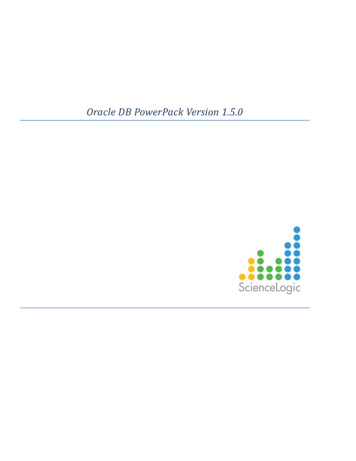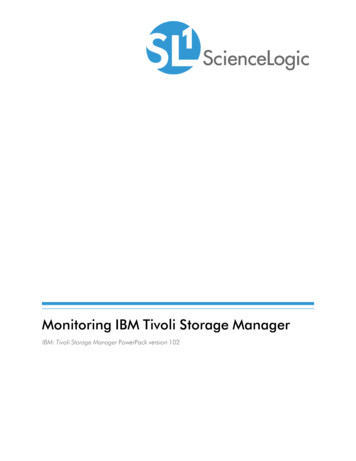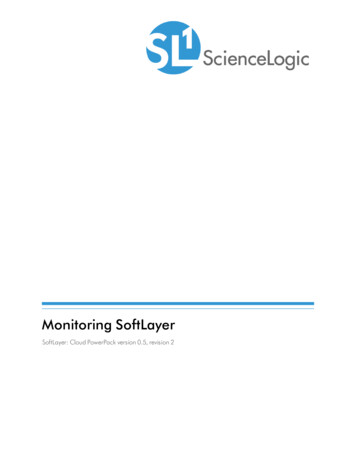
Transcription
Oracle DB PowerPack Version 1.5.0
ContentsSummary . 3Supported Versions. 3Deployment . 3Alert Log Monitoring . 3Oracle DB PowerPack Details. 4Database Status . 4Version Details . 5Datafile Configuration . 5Tablespace Configuration . 6Tablespace Performance . 6Alert Log . 7Linux Alert Log . 8Windows Alert Log . 9Alert Log Events . 9Linux Listener Configuration . 10Linux Database Configuration . 10Performance Ratios . 10Dataguard Status (alpha) . 11Oracle Database Credential . 11Device Templates . 12Referenced Views and Tables . 12Page 2
SummaryThe Oracle DB PowerPack supports configuration, status and performance monitoring of Oracledatabases running on Linux and Microsoft Windows operating systems.The PowerPack uses SQL client connectivity for core database monitoring functionality. The dynamicapplications used for this are identical whether connecting to a Windows or Linux database.The PowerPack also includes optional operating system specific dynamic applications for monitoringthe Oracle alert log via an ssh connection (Linux) or WinRM/Powershell connection (Windows).There are two further Linux dynamic applications for collecting additional listener and databaseinformation, these are most useful on Linux systems with more than one database instance deployed.Supported VersionsThis version 1.2.1 PowerPack has been developed and tested using the following systems: Oracle 12c running on Microsoft Windows 2008 R2 Oracle 11gr2 running on Oracle Linux 6.7 (equivalent to RedHat EL 6.7)There are no known limitations which would prevent this PowerPack from operating with otherdatabase / Windows, Linux operating system combinations currently supported by Oracle, Microsoftand RedHat.DeploymentConnectivity requires a credential for Oracle database access and a credential for operating systemaccess on the target server. The operating system credential (Linux or Windows) must have at leastread access to the Oracle alert xx.log file.For consistent and time-efficient deployment, a device template should be used to align the requireddynamic applications and credentials to the target server. Example Linux and Windows devicetemplates are included in the PowerPack.Alert Log MonitoringMultiple methods are included for alert log monitoring to suit the needs of different environments:MethodDirect operatingsystem access to thealert logDynamic ApplicationOracle DB: Linux Alert LogOracle DB: Windows Alert LogSQL accessreferencing standardviewV DIAG ALERT EXTSQL accessreferencing customview V ALERT LOGSQL accessreferencing tableX DBGALERTEXTOracle DB: Alert Log(default behavior)Page 3Oracle DB: Alert Log(enabled with customcredential)Oracle DB: Alert Log(enabled with customcredential)Advantage Usually fast Works when thedatabase is inaccessible No impact on databaseperformance Supports databasesearlier than 11g Standard view, will worksuccessfully on all recentdatabasesDisadvantage Requires separateoperating systemcredential Requires alert log to berotated before use toavoid lots of events forold alerts Slow to return resultson some databases Performs wellNo special privilegesrequiredPerforms wellBuilt-in to all recentdatabases Requires custom viewto be created beforeuseAccess to the tablerequires SYS privilege,lab use only
You should select only one alert log monitoring method per database, based on which matches yourenvironment. Further details of each method are provided in the PowerPack section below.Oracle DB PowerPack DetailsDatabase StatusUnder normal circumstances the tables on the Configuration tab for this dynamic application will beempty. In the case of a blocking session, invalid object, unusable index or unusable index partitionbeing detected, a major event will be generated and the problem element will appear in the relevanttable on the Database Status configuration table.For testing purposes the snippet which performs these checks has two sets of queries: one forproduction use and one to test events and recording of status information. Testing can be enabled bysetting PRODUCTION False at the top of the oracle status snippet.Additional status checks can be added in future by adding check queries to the production and nonproduction “collections” dictionary and corresponding collection object, alert and event definition:Page 4
Version DetailsThe Version Details dynamic application shows a quick view of versions for each of the databasecomponents.This dynamic application also serves as a reference for: Alert log locationDatabase SIDOperating systemDatafile ConfigurationShows a tabular view of datafile location, size and status.Page 5
A major event will be generated for any datafile whose status is not “ONLINE” or “SYSTEM”. Anexample event message is shown below:Tablespace ConfigurationShows a tabular view of all tablespace information in the database, including number of datafiles,online status and total space.Tablespace PerformanceShows detailed performance information and trend for each tablespace on the system. Includes eventsfor warning and critical utilization levels, and free extents below threshold.Page 6
Example events for this dynamic application:Note:Tablespace utilization alerts are disabled by default in this release. Common practice is toconfigure Oracle datafiles as autoextend on maxsize unlimited. With thisconfiguration, tablespace utilization will typically be very high but Oracle will automaticallyextend the underlying file size as needed. It is very important to monitor the filesystemutilization in this case.If you want to use tablespace utilization alerts, enable them under: System Manage Applications Oracle DB: Tablespace Performance AlertsAlert LogThis dynamic application is used to monitor the Oracle alert log by reference to a view or tablemapped into the text log file. By default the dynamic application refers to the V DIAG ALERT EXTview, which should suit most environments.Warning:A known bug in some versions of Oracle can result in unhandled exceptions indbgrlrReadAlertMsg when this dynamic application is used.Only use the Alert Log dynamic application if one of the following is true: You are running 12.1 or laterYou have applied patch set 11.2.0.4You have applied Patch 13598167 if it is available for your platform and versionSee Oracle support document ID 1433214.1 for further details.The Linux Alert Log and Windows Alert Log dynamic applications below provide alternativemethods for monitoring the Oracle alert log.Alternative Data SourcesThere are two alternative data sources available with this dynamic application which can be enabledthrough the use of a custom credential. Refer to the Alert Log section of this document for furtherdetails on selecting alert log monitoring methods :X DBGALERTEXT Data Source – for lab use only, requires sys privilegesV ALERT LOG Data Source – custom view which must be created before usePage 7
Commands to be executed by the SYS user to create the V ALERT LOG custom view for usewith this dynamic application:create view v alert log as select * from x dbgalertext;create public synonym v alert log for sys.v alert log;grant select on v alert log to em7admin;Replace “em7admin” in the above command with the Oracle user to be used for monitoring.To use one of the alternative data sources, include the required table or view name after a vertical bar‘ ’ at the end of the credential name used with this dynamic application. For example to use theV ALERT LOG view:No matter which source is used, all log entries in the tables containing the “ORA-“ prefix will result ingenerated EM7 events. The log file location and last read position are cached so that only new “ORA“ entries result in events on each execution of the dynamic application.Linux Alert LogThe purpose of this dynamic app is to monitor the text log file for the installed Oracle database on aLinux server. It watches for log entries matching a certain prefix (ORA - ) and promotes them to alertsand then events so that the administrator can handle them.The first time this dynamic application runs it performs a look-up to find the Oracle alert log. In orderfor this look up to be successful, the ORACLE SID environment variable must be set for the Linuxaccount used for login after the local .profile or .bash profile environment files are executed.Once the alert log file has been located all log entries containing the “ORA-“ prefix will result ingenerated EM7 events.The log file location and last read position are cached so that only new “ORA-“ entries result in eventson each execution of the dynamic application. Example EM7 device log entries from the alert log areshown below:The Oracle database alert file may contain a long history of issues, so to avoid generating a largenumber of events when first run, it is recommended to backup and empty the alert log before thedynamic application is aligned.Page 8
Windows Alert LogThe purpose of this dynamic app is to monitor the text log file for the installed Oracle database on aWindows server. It watches for log entries matching a certain prefix (ORA- ) and promotes them toalerts and then events so that the administrator can handle them.PrerequisitesThe first time this dynamic application runs it performs a look-up to find the Oracle alert log. For thislookup to be successful, the alert log location must already have been collected and cached on theEM7 collector. Specifically: The Oracle DB: Version Details dynamic application must be aligned to the device from which alertlogs are to be collectedAt least one successful scheduled collection of the Oracle DB: Version Details dynamic application (seeabove for details of this dynamic application).Once the alert log file has been located, all log entries containing the “ORA-“ prefix will result ingenerated EM7 events.The log file location and last read position are cached so that only new “ORA-“ entries result in eventson each execution of the dynamic application. Example EM7 device log entries from the alert log areshown below:The Oracle database alert file may contain a long history of issues, so to avoid generating a largenumber of events when first run, it is recommended to backup and empty the alert log before thedynamic application is aligned.Alert Log EventsBy default most ORA- alerts will result in major EM7 events. Alerts which start with ORA-125 orORA-126 indicate problems connecting to the database and these will result in critical EM7 events:The event policy “weight” feature in EM7 allows additional event policies to be added in future whenmore specific handling is needed.Page 9
Linux Listener ConfigurationThis is an optional Linux-only dynamic application which provides configuration information aboutthe Linux database listener.Linux Database ConfigurationThis is an optional Linux-only dynamic application which provides configuration information aboutthe Linux database configuration. This can be useful on Linux hosts with multiple Oracle instancesrunning on them.Performance RatiosThis dynamic application provides a key set of performance ratios which are commonly helpful toDBAs in tuning database configuration as well as providing guidance to application developers. Itincludes adjustable thresholds for each of the metrics and corresponding high-water events and lowwater clears.Page 10
Dataguard Status (alpha)The Dataguard status dynamic application monitors the Oracle v dataguard status table and generatesevents for any records for which the CALLOUT field is set to ‘YES’.ScienceLogic events will begin with the text ‘Oracle Dataguard’ followed by the message severity,message text, error code, destination ID, facility and message number. The Dataguard messageseverity is mapped onto ScienceLogic standard severities. The last message ID is stored betweendatabase polls so that only one event is generated for each status message.This dynamic application is currently in alpha status and requires validation against a Dataguardsystem. The Dataguard status dynamic application is disabled by default.Oracle Database CredentialAn example Oracle database credential record is also included in the PowerPack for reference asshown below.Page 11
Device TemplatesThe PowerPack contains three device templates, one for each of the supported operating systems andone general purpose template when no direct database access is required: Oracle DB: Linux ServerOracle DB: Windows ServerOracle DB: Server (No OS credential)The device templates include the required dynamic application for alignment to each of the operatingsystems as appropriate. Prior to use, the specific local credentials should be added to these templates.The alpha Dataguard status dynamic application is not included in device templates.Referenced Views and TablesThe following SQL can be used to create a user named silo with access to the required views andtables are referenced by this PowerPack:CREATE USER silo IDENTIFIED BY password123DEFAULT TABLESPACE USERSTEMPORARY TABLESPACE TEMPPROFILE DEFAULTACCOUNT UNLOCK;GRANT CONNECT TO silo;GRANT SELECT ON v version TO silo;Page 12
GRANT SELECT ON v lock TO silo;GRANT SELECT ON v session TO silo;GRANT SELECT ON v sysstat TO silo;GRANT SELECT ON v rowcache TO silo;GRANT SELECT ON v dispatcher TO silo;GRANT SELECT ON v latch TO silo;GRANT SELECT ON v librarycache TO silo;GRANT SELECT ON v rollstat TO silo;GRANT SELECT ON v parameter TO silo;GRANT SELECT ON v tablespace TO silo;GRANT SELECT ON v diag alert ext TO silo;GRANT SELECT ON v tempfile TO silo;GRANT SELECT ON v open cursor TO silo;GRANT SELECT ON dual TO silo;GRANT SELECT ON dba objects TO silo;GRANT SELECT ON dba indexes TO silo;GRANT SELECT ON dba ind partitions TO silo;GRANT SELECT ON dba tablespaces TO silo;GRANT SELECT ON dba free space TO silo;GRANT SELECT ON dba temp free space TO silo;GRANT SELECT ON dba temp files TO silo;GRANT SELECT ON dba data files TO silo;GRANT SELECT ON dba hist filestatxs TO silo;GRANT SELECT ON dba hist snapshot TO silo;Note: Oracle synonyms in format V VIEWNAME are used in the PowerPack for views namedV VIEWNAME. The above SQL grants read access on the V name rather than the synonym.Page 13
The Oracle DB PowerPack supports configuration, status and performance monitoring of Oracle databases running on Linux and Microsoft Windows operating systems. The PowerPack uses SQL client connectivity for core database monitoring functionality. The dynamic applications used for this are identical whether connecting to a Windows or Linux database.










